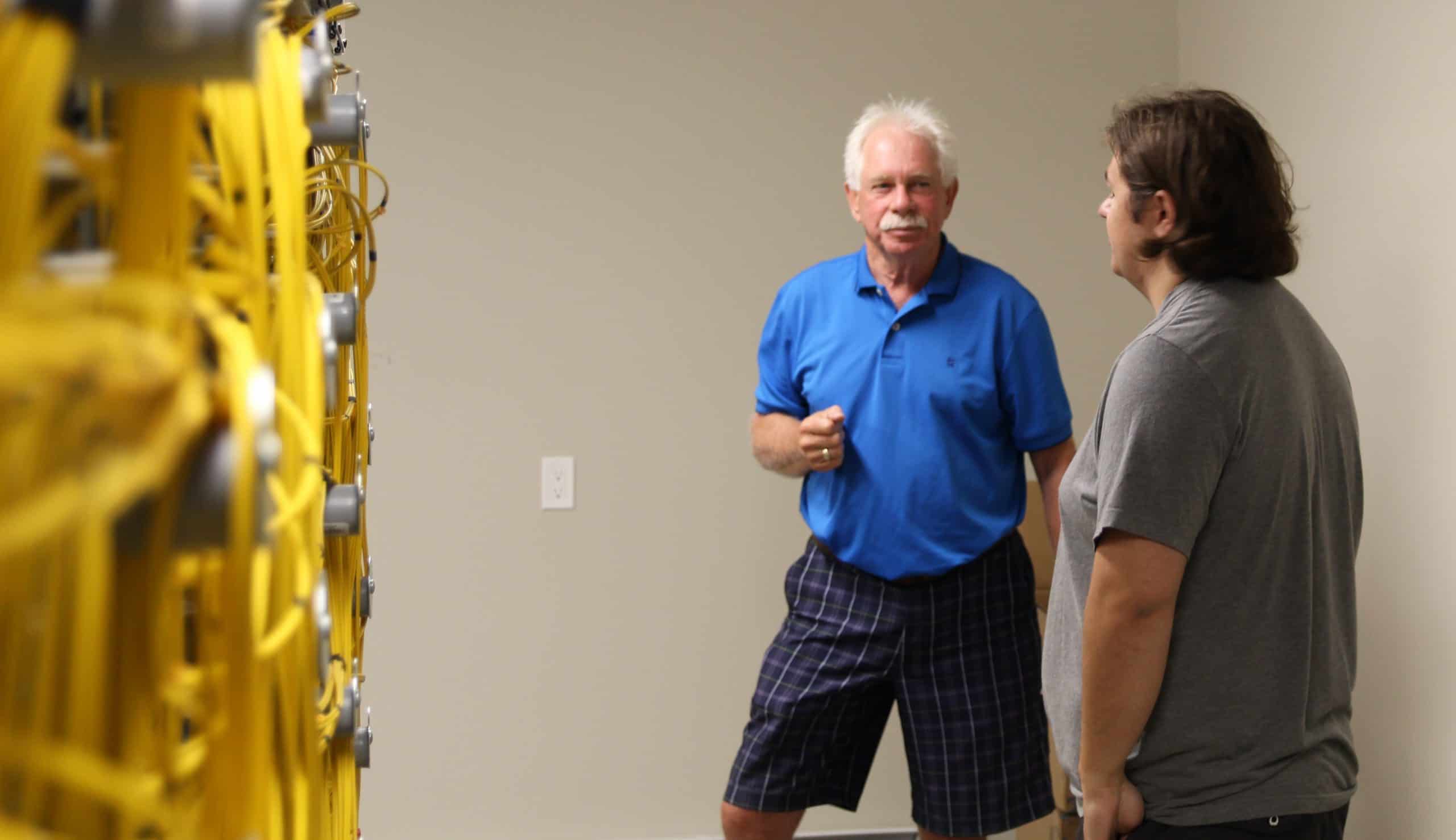Hamiota Mayor Larry Oakden and The Backroad Diaries’ Jack Thompson
The rural municipality of Hamiota, Manitoba is full of creative thinkers who aren’t afraid to try something new. So, when residents decided they wanted faster rural internet, these entrepreneurs thought “let’s start a co-op”.
Behind every co-operative are doers and innovative thinkers — people not content to wait around and instead do things themselves. Armed with a desire for a service and some knowledge of how co-ops worked, the innovative people of Hamiota, the Park West School Division, and two adjoining municipalities created the Park West Fibre Optic Co-op.
Now, this quiet area in the southwest corner of the province has better, faster rural internet than most cities in Canada. The area certainly lives up to its slogan, “Leaders in Community Innovation.”
The trouble with rural internet access
All communities need access to high-quality internet to stay vibrant and relevant, but for rural areas this can be a struggle. The federal government’s target is for everyone in Canada to have access to internet with 50 megabit-per-second download and 10 MBPS upload speeds — but as of 2018, 4.9 million Canadians lacked this access. By far and away rural areas are taking the hardest hit. While these speeds are available to 97 per cent of urban households, a meagre 37 per cent of households in rural areas have the same access.
In its recent consultation and report on rural economic development, the Government of Canada recognized that high speed internet is the top priority for rural residents across the country. It outlined its Connectivity Strategy, in which it plans to provide access to all Canadian households by 2030. A decade is a long time to wait, and the implications for a small market economy could be huge. What if your community doesn’t want to wait that long? With a co-op, you can do it yourself.
Related: How to become the most connected community in Canada
DIY Internet
The Park West Fibre Optic co-op has 140 kilometres of fibre optic cable in the ground, which stretches from one end of its school division to the other, and provides download speeds up to 1 gigabyte-per-second.
“It’s instant,” said Hamiota mayor and founding co-op member, Larry Oakden. “There’s no buffering, there’s no nothing, you can stream movies probably four or five at a time. It just keeps rattling on through.”
About 70 per cent of households in the municipality have signed up for the internet service, and in the surrounding rural area it’s almost 100 per cent. There is even free wifi at the sports arena, the health centre, and the campgrounds.
To make these decisions, the co-op is governed by a board made up of elected representatives from each of the partners (the school division and municipalities) — people who know and can respond to the unique needs of their communities.
So how did the Hamiota area start a co-op that’s a rural Internet Service Provider (ISP)? And how could your community do it too? According to Oakden you need good partners, forward-thinkers, and good timing.
Good partners who are forward thinkers
With a co-op, you need a group of people or organizations who are willing to work together. In the case of Hamiota and area, it started with a conversation between the school division’s head of IT and members of the surrounding local councils. “Wouldn’t it be neat,” one of them said, “if we could have access to the school division’s fibre backbone, which has access to a national internet provider?”
It was neat — and from that idea the school division and three surrounding municipalities joined forces to create a rural internet co-operative to build their fibre optic network.
“So we got thinking about this and then we started putting numbers together,” said Oakden. “[We] hired a consultant, and lo and behold council sat around the table and said ‘you know what, we need to take this to our community’. Have a public meeting, explain to them what we were anticipating — and lo and behold I would say probably upwards of 80 to 85 per cent of the public that came out for the information meeting were gung-ho for it.”

Time it right
Timing is important to set up a system like the Park West Fibre Optic Co-op. Because the school division and the municipalities decided to install the fibre optics together it worked out well. The school division installed the ‘back bone’, and the municipalities were able to tap into that at the same time.
“We know of other communities that have tried in Manitoba to perform similar situations to what we had, but their school divisions have already got their fibre in the ground and it’s functioning well. To try to hook up after the fact quite often that doesn’t go over too well,” Oakden said.
Is this the only way to set up rural internet service? Absolutely not. But if this option is available to your community, it’s an excellent opportunity to explore.
Do your research and learn the lingo
Then, of course, there’s the technical bits. Who knows how to procure and install fibre optic cables? What’s a gigabyte? What’s the difference between fibre and “dark fibre”? The folks in Hamiota had to figure all that out – but they also had help. A consultant was able to recommend a company that could handle the installation and advise them on other technical aspects. They also tapped local expertise: the school division’s head of IT at the time taught the board understand the IT language they needed to speak, and helped them make tech-y decisions.
Related: Finding opportunity for self-determination in a “digital divide”
Figure out how to pay for it
How much does this all cost? Quite a bit, as you’ve probably guessed.
Oakden said the backbone, hooking switches, and cable for their co-op cost around $4.65 million. The school division took out a loan for 70 per cent of the cost, and each of the municipalities was responsible for 10 per cent.
To break even, they knew they needed about 60 per cent of households to sign up for the service, and they have more than that now. Outside the town in the rural areas, almost 100 per cent of households have signed on. (Before the co-op came online, farms might get download speeds of two to five MBPS – now for about the same price they get speeds 20 to 50 times higher).
Get started on faster rural internet!
Think your community could benefit from creating its own ISP co-operative? Get a group of like-minded people together and start strategizing.
“You don’t just sit back and wait for the government or whomever to hand it to you,” said Oakden, “you get out there and you pound the pavement and you work towards either creating it or implementing it through whatever system or organization you need to do. Simple.”
When you’re ready to explore this opportunity, give Co-operatives First a call. We can help you navigate the co-op start-up process, and link you up with other professionals to help you along the way.




